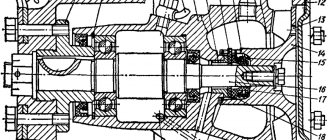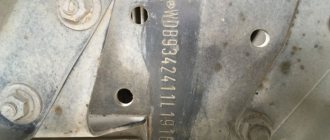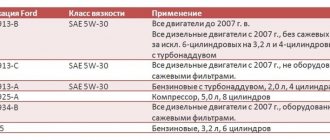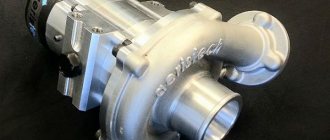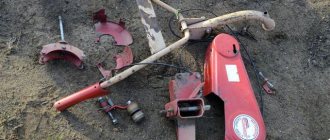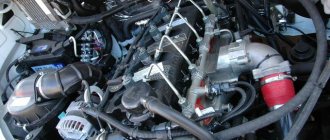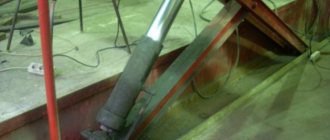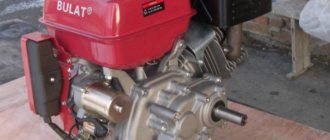According to the analytical agency Autostat, in Russia the share of cars with diesel engines is approximately 5%. In Europe, dieselization progressed at a rapid pace, from World War II until Dieselgate in 2020. In the USA, which started this process, diesel cars have always not been very good, and after the scandal, sales went down. Our car enthusiast has little interest in the environment, to put it mildly, but the growth of the share of diesel engines on the market is hampered by several prejudices. Let's consider which of them is true and which is not.
Poor starting and poor performance at low temperatures. 20% true
“Behind the Wheel” conducted a comparative cold start test of diesel and gasoline engines. These were the petrol Kia Rio 1.6 and the Kia Sorento Prime with a 2.2-liter turbodiesel (both cars were fresh, with minimal mileage). It turned out that both engines start at -33°C and do not come to life at -36°C.
The Korean crossover in the freezer confirmed its high starting qualities at low temperatures.
The Korean crossover in the freezer confirmed its high starting qualities at low temperatures.
Diesel engines have high torque. Fair
A diesel engine by its nature does have more torque than a gasoline engine due to the higher effective pressure in the cylinder. This is due to longer combustion at constant pressure in the cylinder. This was the case with naturally aspirated diesel and gasoline engines. Nowadays, turbocharged diesel engines (and they don’t produce others) significantly exceed the torque of only naturally aspirated gasoline engines.

External speed characteristics of two engines of similar power installed on the Renault Duster: A - K9K diesel engine; B — gasoline engine K4M.
External speed characteristics of two engines of similar power installed on the Renault Duster: A - K9K diesel engine; B — gasoline engine K4M.
But gasoline engines with direct injection and turbochargers are literally stepping on the heels of diesel engines. Their boost control system allows them to provide a wide range of torque, which drivers like so much. Well, this shelf is a little lower than that of diesel engines.
Injector and its device
The operation of an internal combustion power plant is based on the process of converting the energy released during the combustion of a special mixture into mechanical action. But for this process to occur correctly, it requires careful preparation and feeding into the cylinders. And this is done by the fuel system in the power unit.
The task of this system is to supply fuel (one of the components of the mixture) and mix it with air, as a result of which a combustible mixture is formed, before it all enters the cylinder.

It is not for nothing that the internal combustion engine (hereinafter referred to as the ICE) is considered the heart of the car. It is the torque it produces that is the primary source of all mechanical and electrical processes occurring in the vehicle.
However, the motor cannot exist separately from the systems that serve it - lubrication, power, cooling and exhaust gases. The most significant role in the operation of the internal combustion engine is played by the engine power system (or fuel system).
Each car is characterized by such a concept as “power reserve”. It is determined by the distance that a car can travel on a full fuel tank without additional refills.
This indicator is influenced by a variety of factors: seasonal, weather and natural driving conditions, the nature of the road surface, the degree of vehicle load, the individual characteristics of the driver when driving, etc.).
However, the main role in determining the “appetite” of a car is played by the power system and its proper operation.
The power system performs the following functions:
- fuel supply, cleaning and storage;
- air purification;
- preparing a special flammable mixture;
- supplying the mixture to the internal combustion engine cylinders.
The classic car power system consists of the following structural elements:
- a fuel tank designed to store fuel;
- a fuel pump that performs the functions of creating pressure in the system and forcing fuel supply;
- fuel lines - special metal tubes and rubber hoses for transporting fuel from the fuel tank to the internal combustion engine (and excess fuel in the opposite direction);
- fuel purification filter (or filters);
- air filter (to clean the air from impurities);
- devices for preparing the fuel-air mixture.
The power supply system has a fairly simple principle of operation: under the influence of a special fuel pump, fuel from the tank, having previously undergone a cleaning procedure with a fuel filter, is supplied through fuel lines to a device intended for preparing the fuel-air mixture. And only then the mixture is supplied to the engine cylinders.
The main types of fuel for internal combustion engines are gasoline and diesel fuel (“diesel fuel”). Gas (methane) also belongs to the types of modern fuel, but, despite its widespread use, has not yet become relevant. The type of fuel is one of the criteria for classifying internal combustion engine power systems.
In this regard, power units are distinguished:
- gasoline;
- diesel;
- based on gaseous fuel.
But the most recognized among experts is the typology of engine power systems based on the method of fuel supply and preparation of the fuel-air mixture. Following this classification principle, we distinguish, firstly, the power supply system of a carburetor engine, and secondly, the power supply system with fuel injection (or an injection engine).
Carburetor
The carburetor system is based on the operation of a technically complex device - a carburetor. A carburetor is a device that prepares a mixture of fuel and air in the required proportions. Despite the variety of types, in automotive practice the most widely used is the float suction carburetor, the circuit diagram of which includes:
- float chamber and float;
- atomizer, diffuser and mixing chamber;
- air and throttle valves;
- fuel and air channels with corresponding jets.
The preparation of the fuel-air mixture in the carburetor is carried out according to a passive scheme. The movement of the piston during the intake stroke (first stroke) creates a rarefied space in the cylinder, into which air rushes, passing through the air filter and through the carburetor.
It is here that the formation of a combustible mixture occurs: in the mixing chamber, in the diffuser, the fuel escaping from the atomizer is crushed by the air flow and mixed with it. Finally, through the intake manifold and intake valves, the combustible mixture is supplied to a specific engine cylinder, where at the required moment it is ignited by a spark from the spark plug.
Thus, the power system of a carburetor engine is a predominantly mechanical method of preparing the fuel-air mixture.
Read more: Types of automatic transmissions, what types of automatic transmissions are there in cars
Fuel injection
The era of the carburetor is being replaced by the era of the injection engine, the power system of which is based on fuel injection. Its main elements are: an electric fuel pump (located, as a rule, in the fuel tank), injectors (or nozzle), and an internal combustion engine control unit (the so-called “brains”).
The principle of operation of this power system is reduced to spraying fuel through nozzles under pressure created by the fuel pump.
The quality of the mixture varies depending on the operating mode of the engine and is controlled by the control unit. An important component of such a system is the injector.
- with distributed injection;
- with central injection.
The distributed injection system involves the use of injectors according to the number of engine cylinders, where each cylinder is served by its own injector, which is involved in preparing the combustible mixture. The central injection system has only one injector for all cylinders, located in the manifold.
The operating principle on which the diesel engine power system is based stands out as if apart.
Here, fuel is injected directly into the cylinders in atomized form, where the process of mixture formation (mixing with air) occurs, followed by ignition from compression of the combustible mixture by the piston.
Depending on the fuel injection method, the diesel power unit is available in three main options:
- with direct injection;
- with swirl chamber injection;
- with pre-chamber injection.
The swirl chamber and pre-chamber options involve injection of fuel into a special preliminary chamber of the cylinder, where it is partially ignited and then moved into the main chamber or the cylinder itself. Here the fuel mixes with air and finally burns out.
Direct injection involves delivering fuel immediately into the combustion chamber and then mixing it with air, etc.
Another feature that distinguishes the diesel engine power system is the principle of ignition of the combustible mixture.
This does not come from the spark plug (as in a gasoline engine), but from the pressure created by the cylinder piston, that is, by self-ignition. In other words, in this case there is no need to use spark plugs.
However, a cold engine will not be able to provide the proper temperature level required to ignite the mixture. And the use of glow plugs will allow for the necessary heating of the combustion chambers.
Depending on the goals and road conditions, the driver can use different driving modes. They also correspond to certain operating modes of the power supply system, each of which has a special quality fuel-air mixture.
- The mixture will be rich when starting a cold engine. At the same time, air consumption is minimal. In this mode, the possibility of movement is categorically excluded. Otherwise, this will lead to increased fuel consumption and wear of power unit parts.
- The composition of the mixture will be enriched when using the “idling” mode, which is used when coasting or running the engine in a warm state.
- The mixture will be leaner when driving with partial loads (for example, on a flat road at medium speed in high gear).
- The mixture composition will be enriched at full load when the vehicle is moving at high speed.
- The mixture will be rich, close to rich, when driving under conditions of sharp acceleration (for example, when overtaking).
The choice of operating conditions for the power system, therefore, must be justified by the need to move in a certain mode.
During the operation of the vehicle, the vehicle's fuel system experiences loads that lead to its unstable operation or failure. The following faults are considered the most common.
Poor quality fuel, long service life, and environmental exposure lead to contamination and clogging of fuel lines, tank, filters (air and fuel) and technological openings of the combustible mixture preparation device, as well as breakdown of the fuel pump. The system will require repairs, which will consist of timely replacement of filter elements, periodic (every two to three years) cleaning of the fuel tank, carburetor or injector nozzles and replacement or repair of the pump.
Engine power loss
A malfunction of the fuel system in this case is determined by a violation of the regulation of the quality and quantity of the combustible mixture entering the cylinders. Troubleshooting involves the need to diagnose the combustible mixture preparation device.
Fuel leak
A fuel leak is a very dangerous phenomenon and is absolutely unacceptable. This malfunction is included in the “List of malfunctions...” with which the vehicle is prohibited from moving.
The causes of the problems lie in the loss of tightness of the components and assemblies of the fuel system.
Troubleshooting involves either replacing damaged system elements or tightening the fuel line fastenings.
The essence of the functioning of the injector is that fuel is forcibly injected into the passing air flow. In this case, gasoline is supplied under pressure, which ensures its atomization, thereby improving its mixing with air.
Diesel engines are more harmful to the environment. 30% true
Despite diesel gates, modern diesel is very good from an environmental point of view. Take a look at this table.
Composition of exhaust gases from gasoline and diesel engines:
| Component | Content in exhaust gases, % vol. | Harmfulness | |
| Diesel | Spark ignition engine | ||
| N₂ | 74–78 | 74–77 | Harmless |
| O₂ | 2,0–20,0 | 0,3–10,0 | Harmless |
| H₂O | 05–11,0 | 3,0–5,5 | Harmless |
| CO₂ | 1,0–16,0 | 5,0–12,0 | Causes a greenhouse effect |
| CO | 0,005–0,4 | 0,5–12,0 | Toxic |
| NOx | 0,004–0,5 | 0,01–0,8 | Toxic |
| CnHm | 0,005–0,3 | 0,2–3,0 | Toxic |
| Aldehydes | 0,001–0,009 | 0–0,2 | Toxic |
| Soot | 0.01–1.1 g/m³ | 0–0.04 g/m³ | Toxic |
| Benz(a)pyrene | 0.05–1.0 µg/m³ | 0–20 µg/m³ | Carcinogen |
“Filters remove up to 99% of the smallest particles, so this problem no longer exists for modern diesel engines,” says Nick Malden, head of the independent research center Emissions Analytics.
But even the new diesel engine has a particulate filter cleaning function, which is activated in highway modes. At a sufficiently high temperature of the exhaust gases, deposits are burned on the surface of the particulate filter honeycomb. The amount of emissions can be estimated from the theoretical mass of particulate matter, which is taken into account by the Audi Q7 engine ECU. At 40 g, active regeneration is necessary, and at 68 g, the mode is close to emergency - even forced burning will not start. Where do you think these substances will go? That's right - down the pipe. Therefore, if the car ahead of you on the highway begins to smoke intensely with white smoke, then you know that the burning mode has turned on. Either let you pass ahead, or overtake a car that is doing its own maintenance on the move.
Power System Options
Carburetor
Thus, the power system of a carburetor engine is a predominantly mechanical method of cooking
Read more: Do-it-yourself soundproofing of a car roof
Fuel injection
The principle of operation of this power system is reduced to spraying fuel through nozzles under pressure created by the fuel pump. The quality of the mixture varies depending on the operating mode of the engine and is controlled by the control unit. An important component of such a system is the injector. The typology of injection engines is based precisely on the number of injectors used and their location.
Diesel engines are installed only on large cars. Not true
In our country, due to the peculiar attitude towards diesel engines, the smallest volume is the one and a half liter K9K engine with a power of 109 hp, installed on the Renault Duster. Everything else is multi-liter diesel engines for heavy vehicles.
But in Europe and even from our closest neighbors you can buy cars with diesel engines with a displacement of 0.799 liters or more. And why not: there will be no special problems with operation in warm climates. Small diesel cars are not brought to our country because there is no demand for them. A small car of any kind consumes relatively little fuel. The savings are not that great, but everyone is afraid of the difficulties of winter operation.
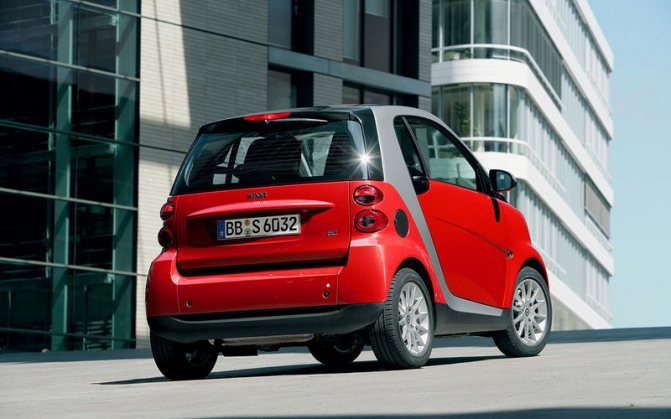
Double diesel car Smart fortwo 0.8 CDi. Three cylinders, but there is also common-rail direct fuel injection and turbocharging.
Double diesel car Smart fortwo 0.8 CDi. Three cylinders, but there is also common-rail direct fuel injection and turbocharging.
Ice and fire: who invented the diesel engine
The boy, born in 1858 in Paris into a family of emigrants from Bavaria, already at the age of 14 knew for sure that he wanted to become an engineer. He was destined to invent one of the main engines of technological progress - in the most literal sense of the word. The boy's name was Rudolf Diesel.
In 1870, the Franco-Prussian War began, and the Diesel family was forced to emigrate a second time - to London. 12-year-old Rudolf was sent to receive his education at a real school in Augsburg, where his uncle taught mathematics.
At the age of 15, he entered the Augsburg Industrial School, after which he received a scholarship to study at the Higher Polytechnic School in Munich. One of his teachers, who taught a course in thermodynamics, was Karl von Linde, one of the founders of cryogenic technology, the developer of a method of cooling and separation of gases, and in fact the inventor of the refrigerator. In 1880, Diesel graduated with honors from the Munich Hochschule and went to Paris, where he soon headed a branch of the ice production company owned by von Linde. And soon he received the first patent for a method for making transparent ice.
But Rudolf Diesel's real dream was not ice at all, but fire - he wanted to improve the internal combustion engine designed by August Otto, invented shortly before. From the point of view of Diesel himself, the Otto engine had significant drawbacks - in particular, its efficiency at that time was only 15%, and the ignition system was complex and unreliable. Diesel tried to get around these limitations by experimenting with the thermodynamic Carnot cycle and then developing his own cycle.
In 1892, he filed the first patent application for the “principle of operation and design of an internal combustion engine,” and in 1893, the second, and at the same time published the work “Theory and Design of a Rational Heat Engine to Replace Steam Engines and Existing ICEs.” Rudolf Diesel's main idea was that he abandoned the ignition system (the fuel was ignited by air heated during the compression process), as well as the carburetor, replacing it with a high-pressure pump.
In 1893, Diesel began preparations for the production of his engines at the MAN plant (Maschinenfabrik Augsburg-Nurnberg), but debugging of the prototypes proceeded slowly and lasted right up to 1897. The first production models were used as stationary ones and were far from perfect - both in terms of practical efficiency and reliability, causing many complaints from buyers. The inventor’s dream that his engines would appear in vehicles began to come true only in 1903, when the first marine diesel engine appeared.
The first MAN truck with a diesel engine was released only in 1924, but the inventor did not live to see this event: on September 29, 1913, he boarded the Dresden mail steamer in Antwerp, going to London, and a week later his body was fished out of the English Channel.
Biographers are of the opinion that it was a suicide caused by financial troubles and crisis. The article “Ice and Fire” was published in the magazine “Popular Mechanics” (No. 7, July 2013).
Some cars can only be purchased with diesel. Is it true
Some models can be purchased in our country only with a diesel engine. This often happens because only diesel modifications have tax-effective power of up to 250 hp. For example, Audi Q7. Although the luxurious SQ8 is also equipped with a 422 hp diesel engine.
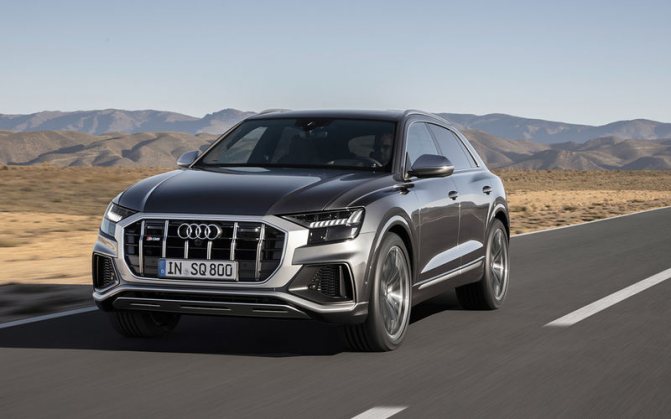
The premium cross-coupe SQ8 from Audi is equipped only with diesel engines.
The premium cross-coupe SQ8 from Audi is equipped only with diesel engines.
Speed control
Unlike gasoline engines, diesel engines have no throttle, so the amount of air they consume remains the same. The engine speed is determined only by the volume of fuel injected into the combustion chamber. The more fuel, the more energy is released during combustion.
The gas pedal is connected to a sensor in the ignition system, and not to the throttle, as in cars that run on gasoline.
To stop the diesel engine, you still need to turn the ignition key. In a gasoline engine, the spark disappears, and in a diesel engine, the solenoid responsible for supplying fuel to the pump is turned off. After this, the engine consumes the remaining fuel and stops. In fact, diesel engines stop faster than gasoline engines because the high pressure slows them down so much.
